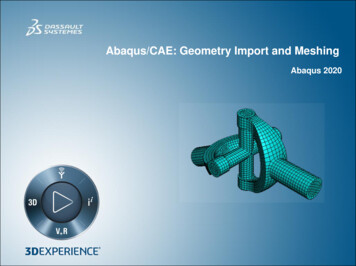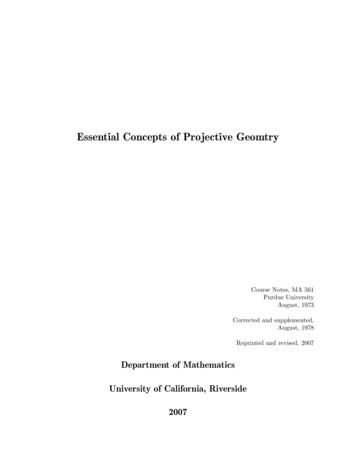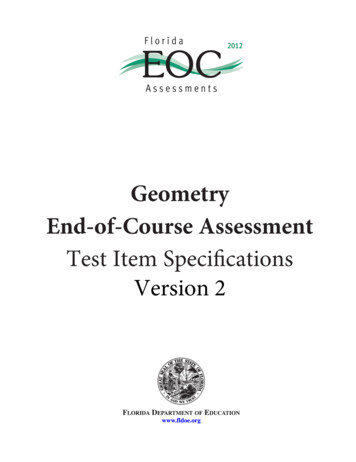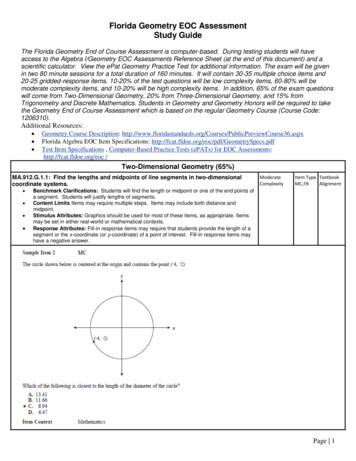
Transcription
U.U.D.M. Project Report 2020:46An Introduction to Kleinian Geometry viaLie GroupsJosefin WahlströmExamensarbete i matematik, 15 hpHandledare: Georgois Dimitroglou RizellExaminator: Martin HerschendSeptember 2020Department of MathematicsUppsala University
AbstractIn 1872 Felix Klein published the Erlangen program where he proposed a system to classifyand compare the existing geometries at the time. The structures used to describe them areknown as Klein geometries which are based on Lie groups. Another type of geometry isRiemann geometry. This thesis will define Klein and Riemann geometry and examine someknown examples of geometry from the point of view of these.2
Contents1Introduction2Lie Groups2.1 Algebra . . . . . .2.2 Topology . . . . .2.3 Lie Group . . . . .2.4 Riemann Geometry4.44711113Klein Geometry134Examples4.1 Euclidean Geometry . . . . . . . . . . . . . . .4.2 Spherical geometry . . . . . . . . . . . . . . . .4.3 Complex Projective Geometry in One Dimension4.4 Hyperbolic Geometry in Two Dimensions . . . .14141617193.
1IntroductionIn 1872 Felix Klein published the Erlangen program where he proposed a system to classifyand compare the existing geometries at the time. The idea was to use algebra to describe thetransformations that preserve the invariants of the underlying space of the geometry. The transformations form an algebraic group which acts on the space, making it homogeneous. Thereforethe underlying space can be described as the quotient of the group of transformations with oneof its subgroups that has certain properties. The group belongs to a specific type of groupscalled Lie groups. This means that they are smooth manifolds such that their group structurecoincide with a certain topological property, and therefore they are useful for describing thesymmetries of a space. This perspective on geometry is called Klein geometry.During the 19th century Bernhard Riemann originated what is called Riemann geometry. Thistype of geometry studies Riemann manifolds; smooth manifolds who admits a Riemann metric.With these metrics isometries of the manifolds can be defined and studied, and these isometriesform a group that acts on the manifold in question. When this group acts transitively on thespace it turns it into a homogeneous Riemann manifold. This is similar to Klein geometry andthe two perspectives coincide at times.In this thesis I will define what Klein geometry (and Riemann geometry) is, give an idea of itsusefulness, and present four relevant examples: Euclidean, spherical, projective, and hyperbolicgeometry. The latter two will only be done in one and two dimensions respectively.2Lie GroupsLie groups are an essential part of the study of Klein geometry. They are spaces that have bothalgebraic and topological properties who coincide in such a way that they represent symmetrieswell. To properly define a Lie group firstly groups and manifolds, and their related conceptsmust be defined and discussed.2.1AlgebraThe following section will cover the relevant parts of group theory needed for discussing Liegroups. A group is a set together with a binary operation which gives the set a particularstructure. This structure is the same that the integers gets from (the usual) addition and it can bedescribed in the following way. The set is closed under the operation, meaning that no elementoutside of the set can be obtained by using the operation on two elements of the set. The result ofthe operation of two elements must therefore still lie in the set. The operation is associative, andthere is a unique element of the set called the identity element (or just the identity), exhibitingthe same properties as 0 does in Z with respect to addition. These properties are the following:the operation of the identity and an element in the set will always be the element, and everyelement has an inverse element such that these two elements under the operation is the identity.These properties are formalized in the definition below.Definition 2.1. A group is a set G together with a binary operation · called multiplication on G,written (G, ·), such that4
(i) a · b G, a, b G(ii) (a · b) · c a · (b · c), a, b, c G(iii) e G such that e · a a · e a, a G(iv) a G, y G such that a · y y · a eAbove the identity is denoted e, and the inverse of x is y.Example 2.1. Some examples of groups that will be important later are The orthogonal group of dimension n: (O(n), ·) where O(n) is the set of all orthogonal (Msuch that M T M 1 ) , n n matrices with real entries and ’·’ is matrix multiplication. The Euclidean group of dimension n: (E(n), ), where E(n) is the set of all isometries ofRn and ’ ’ is function composition. The general linear group: (GLn (F), ·), where GLn (F) is the set of all n n invertiblematrices (ie with non-zero determinant) with entries from F (R or C), and ’·’ is matrixmultiplication. The special linear group: (SLn (F), ·), where SLn (F) is the set of all n n matrices withdeterminant 1 with entries from F (R or C), and ’·’ is matrix multiplication. Special orthogonal group: (SO(n), ·), where SO(n) is the set of all n n orthogonal matrices with determinant 1.The above examples except for the Euclidean group are so-called matrix groups. A handy toolwould be to determine if two groups are structurally the same. This tool exists and it is calledgroup homomorphisms.Definition 2.2. A group homomorphism between two groups (G, *) and (H, ·) is a functionf : G H such that f (a b) f (a) · f (b) holds for all a, b G.A bijective homomorphism is called an isomorphism (and the groups are then isomorphic). Anisomorphism from a group to itself is called an automorphism, and the set of all automorphismsof a group G form the automorphism group Aut(G). Another thing that would be handy is if asubset of a group could inherit the structure.Definition 2.3. A subgroup of a group G is a subset H of G such that(i) e H(ii) x H x 1 H(iii) x, y H x · y HA subgroup is denoted as H G.5
Example 2.2. Some examples of subgroups are: the set {e} is called the identity subgroup, and is a subgroup of every group O(n) is a subgroup of E(n) SLn (F) is a subgroup of GLn (F) SO(n) is a subgroup of O(n) the stabilizer subgroup of any group will be defined later.With the subgroup of a group one can divide the group into disjoint subsets of equal size. Theseare called cosets.Definition 2.4. If G is a group and H G, then the (left) coset of H in G with respect to anelement g G is the setgH {g · h h H}Example 2.3. Some examples of cosets are: if H {. 4, 2, 0, 2, 4.}, G Z, then the coset w.r.t. 1 Z is1{. 4, 2, 0, 2, 4.} {. 3, 1, 1, 3, 5.} H is the coset of a for all a HThe right coset is the set Hg, and H is called a normal subgroup if and only if the right and leftcosets coincide for all g G.Example 2.4. Some normal subgroups are: N {e}, for any group G. N G for any group G. N G where G is an abelian group (ie when the group operation is commutative) The translation group T (of all translations) is a normal subgroup of the E(n) in anydimensionThe set of all cosets of a subgroup from a set, and if the subgroup is normal it becomes a group.This is referred to as taking the quotient of the subgroup.Definition 2.5. Let N be a normal subgroup of a group G. The quotient group with respect toN is the set of cosets of N:G/N {gN g G}The group structure of the quotient group is inherited from (G, ·G ) and N in the following way:6
(i) e eN is the identity element(ii) · is the operation such that aN · bN (a ·G b)N(iii) a 1 N is the inverse of aNGroups can also act on arbitrary sets by associating a permutation of the set to an element of G.This is called a group action.Definition 2.6. A (left) group action of a group G on a set X is a mappingG X X(g, x) 7 g · xsuch that(i) 1·x x, x X(ii) g·(h · x) (gh) · x, g, h G, x XA group action generates a subgroup with respect to an element of the set. The action is said tobe transitive if X is non-empty and if for all x, y X there exists a g G such that g · x y.Definition 2.7. Let G act on X. The stabilizer of a point x X is the set {g G g · x x}.The stabilizer of any point x of X is a subgroup of G, containing all the elements of G that takesthe point to itself and it is denoted G x .2.2TopologyThe following section will cover the relevant parts of topology needed for discussing Lie groups.These parts are basic topology and manifolds (in particular smooth manifolds.) A topologyis a set together with a collection of subsets. The intuition behind a topology is to measure”closeness” in a vague sense. If two elements are part of the same set in the collection they are”close” to each other. Keep in mind that this closeness has nothing to do with the actual metricdistance between the points. A manifold is a type of a topological space that has additionalstructure that admits additional properties that are important.Definition 2.8. A topology on a set X is the pair (X, T ) where T is a collection of subsets of Xsuch that(i) X T and T(ii) the union of the elements of any subcollection of T is in T(iii) intersections of any finite subcollection of T is in T7
The elements of T are called the open sets of X (with respect to the topology T ) and the complement of an open set is called a closed set. They are denoted U op X and U cl X respectively.Furthermore X is referred to as a topological space, or space for short.Example 2.5. Some examples of topologies are (X, T ) where X is any set and T {X, }. This is called the trivial topology (X, T ) where X is any set and T is the set of all subsets of X. This is called the discretetopology (Rn , T ) where T is the set of all unions of all ε-balls Bε (x) centered at the point x, containing all the points which is less than distance ε 0 away from x. This is called thestandard topology on Rn . If (X, T ) is a topology and S X is a subset, the the subspace topology on S is T S {S U U T } The quotient topology requires more legwork and will be defined below.When referring to Rn as a space, it is implied that it is with the standard topology. The samegoes for if something is referred to as a subspace of a topological space, then it is implied thatit is with the subspace topology. A closed subspace that also is a subgroup of GLn (F) are calledmatrix groups. The last topology mentioned is the quotient topology. It can be thought of asgluing parts of spaces together to get new spaces, usually with the help of equivalence classes.It is defined with the help of a map called a quotient map.Definition 2.9. Let X and Y be topological spaces. A quotient map is a surjective map q : X Y such that U op Y if and only if q 1 (U) op XDefinition 2.10. Let X be a space and A a set. The quotient topology T on A is the uniquetopology T such that a surjective map q : X A is a quotient map. Then T is called thequotient topology induced by q. If is an equivalence relation on X, then the quotient space isX/ , where the quotient map q : X X/ exists. (Here q is the canonical map.)Moving on to the ways that topological spaces can relate to one another, there are maps thatsomewhat ensure a certain amount of structure. These are called continuous maps.Definition 2.11. A map f : X Y where X and Y are topological spaces, is a continuous mapif V op Y: f 1 (V) op X.In other words, the pre-image of every open set in Y is open in X.The continuity of a map is a very useful concept, and one of its more important uses are in thedefinition of the tool to see if two topological spaces have the same topological structure. Thistool is referred to as homeomorphisms.Definition 2.12. A map f : X Y, where X and Y are topological spaces, is a homeomorphismif(i) f is a bijection8
(ii) f is continuous(iii) the inverse function f 1 is continuousTwo topological spaces are said to be homeomorphic if there exists a homeomorphism betweenthem. The topological structure that homeomorphisms preserve can be seen as a set of properties. These properties are called topological properties, or topological invariants, and some ofthem will be defined below.Example 2.6. Some examples of spaces that are homeomorphic are the interval (a, b) is homeomorphic to R, a, b R, a b the unit sphere in R3 with one point removed is homeomorphic to R2 through stereographic projection. R2 is homeomorphic to CNow to some examples of topological properties: connectedness and compactness.Definition 2.13. A connected space is a topological space that cannot be represented as theunion of two or more (nonempty) disjoint open sets.Definition 2.14. An open cover of a topological space X is a collection of open subsets suchthat their union is equal to X.Definition 2.15. A space X is compact if every open cover of X contains a finite subcollectionthat also covers X.There exists a handy theorem used to determine the compactness of certain spaces.Theorem 2.1. A subset of Rn is compact if and only if it is closed and bounded. Proof. can be found on page 40 of [5]It is now time to define the kind of topological space known as a manifold. There are severalway to define a manifold and here a ”simpler” one will be used. Intuitively, a manifold can beseen as pieces of a big real space ”glued” together. In other words, they are spaces that locallylooks like RN . The formal definition is somewhat technical.Definition 2.16. A manifold M is a subspace of RN such that for each point x in M, there existsan open set U containing x such that U is homeomorphic to an open subset V of Rn , n N.Then M is called an n-manifold.Example 2.7. Some examples of manifolds are Rn trivially, since every open subset of Rn is homeomorphic to itself All matrix groups are manifolds.9
Like groups and regular topological spaces, manifolds can have a substructure as well. This iscalled a submanifold and is defined as follows.Definition 2.17. A subset N of an n-manifold M is a submanifold of dimension k if for eachx N there exists an open subset U of M containing x, and a homeomorphism f : U V,V op Rn such thatx f 1 (V (Rk {0})) N UThis can be though of as N inheriting the homeomorphisms for x from M. A special typeof manifolds are smooth manifolds. These have an additional structure that ensures that the”surface” of the manifold is well-behaved. The structure is called smoothness and is first definedin relation to maps.Definition 2.18. Let U and V be open subsets of Rn and Rm respectively. A map f1 : U V iscalled smooth if its partial derivatives of all orders exists and are continuous.Now let X and Y be arbitrary subsets of Rn respectively Rm . Then a map f2 : X Y is calledsmooth if for all x X there exists an open set U op Rn containing x and some smooth mapF : U Rm where F and f2 coincides on U X.It is worth noting that the composition of two smooth maps is also a smooth map. Like continuous maps, smooth maps play a role in the definition of the tool used to determine if two(differentiable) manifolds have the same structure. This tool is called a diffeomorphism.Definition 2.19. A diffeomorphism is a map f : X Y between subsets of Rk and Rl respectively such that(i) f is a homeomorphism(ii) f is a smooth function(iii) f 1 is a smooth functionWith the definition of a diffeomorphism, the definition of a smooth manifold can be made.Definition 2.20. An n-dimensional smooth manifold is a subspace M RN where every x Mis contained in an open set U of M that is diffeomorphic to an open subset V of RnSuch a diffeomorphism φ : V U is called a parametrization of the neighbourhood U. Theinverse φ 1 is called a coordinate system on U. Note that all smooth manifolds are topologicalmanifolds, since any diffeomorphism is in particular a homeomorphism. Smooth manifolds alsohave a way of generating substructures. The definition for this is fairly simple.Definition 2.21. A smooth submanifold N M is a submanifold of a smooth manifold M RN ,where N RN is itself a manifold.10
2.3Lie GroupA Lie group is a set which has both algebraic and topological properties. It belongs to a biggertype of structure known as a topological group, in which the group operation and inversionmap are continuous with respect to the topology. Lie groups are topological groups that aremanifolds, with some extra constraints. This type of structure makes it so that Lie groups arewell-suited for describing symmetries of spaces.Definition 2.22. A Lie group G is an algebraic group that is also a smooth manifold such that(i) the multiplication function G G G : (a, b) 7 a · b is a smooth function(ii) the inverse function G G : a 7 a 1 is a smooth functionExample 2.8. Some examples of Lie groups are Rn with group operation addition. Cn with group operation addition. All matrix groups are Lie groupsProof for the last example can be found in section 7.6 of [3]. It can also be shown that allcompact Lie groups are matrix groups (Theorem 10.1 [3]). As with all the other structurespreviously defined, a substructure also exists for Lie groups.Definition 2.23. Let G be a Lie group and H a closed subgroup H G that is also a submanifoldof G. Then H is called a Lie subgroup of G.The restrictions to H of the multiplication and inverse maps on G are smooth, and thereforeH is also a Lie group in itself. Topological groups and their subgroups can together form newtopological spaces on which the group can act. These are called coset spaces and are defined asfollows.Definition 2.24. A coset space is the (algebraic) quotient G/H of a topological group G, whereH is a subgroup of G. This is a topological space equipped with the quotient topology withrespect to the relation:x y x · y 1 H.If H is normal then G/H inherits the group structure as well. G will act on X G/H throughthe continuous group action g(g0 H) (gg0 )H, (g0 , g G). This action is transitive, making X ahomogeneous space.2.4Riemann GeometryBefore going into Klein geometry, another type of geometry will be presented first: Riemanngeometry. It is the study of Riemann manifolds and it shares some characteristics with Klein11
geometry. Riemann manifolds are smooth manifolds who have a metric on its tangent spacescalled a Riemann metric. This means that some definitions must first be made to be able todefine a Riemann manifold, starting with the tangent space of a point.Definition 2.25. Let M be a smooth manifold and g a parametrization g : V M, of aneighbourhood g(V) of p such that g(v) p for some v V.g can be thought of as a mapping from V to RN such that the derivative dgv : Rn RN is welldefined. The tangent space of p M is then the image of this derivative, T p (M) Im(dgv (Rn ))This definition does not depend of the choice of the parametrization g, and a tangent space isa vector space, not a topological one. Furthermore, its elements are the tangent vectors of thepoint p and T p (M) is also a subset of RN . Taking tangent spaces of all points of a smooth manifold forms a tangent bundle, which is somewhat important when defining a Riemann metric.Definition 2.26. The tangent bundle T (M) of a smooth manifold M RN is the pair of a pointp in M and a vector in the tangent space of p:T (M) {(p, v) RN RN p M, v T p (M)}The tangent bundle of a smooth manifold in RN is itself a smooth manifold contained in RN RN .Some other things needed for defining a Riemann metric are bilinear forms and inner products.Definition 2.27. A bilinear form on a vector space V is a function B : V V R such that forall u, v, w V and for all a, b R the following holds:B(au bv, w) aB(u, w) bB(v, w)B(w, au bv) aB(w, u) bB(w, v)A bilinear form is called symmetric if B(u, v) B(v, u) for all u, v V positive definite if B(u, u) 0 for all u V with equality if and only if u 0.Definition 2.28. An inner product on a vector space is a bilinear form that is symmetric andpositive definite. It is denoted h·, ·i.A Riemann metric is a collection of inner products on the tangent space of every point of asmooth manifold, such that the inner products varies smoothly on the point as the point varieson M. This is formally defined as follows.Definition 2.29. Let g be a collection of inner products on a smooth manifold M. A Riemannmetric g is a smooth function fromT (M) T (M) {(p, v, w) M RN RN p M, v, w T p (M)} RN RN RNto R that is an inner product on every T p (M) T p (M).This metric ensures that some geometric properties can be discussed and defined on the smoothmanifold. Examples of these properties are angles, length of curves, and curvature of surfaces,all which are important concepts i geometry.12
Definition 2.30. A Riemann manifold is a pair (M, g) of a smooth manifold M and a Riemannmetric g on M.The Riemann metric makes it so that area, angles, and distance between points are well-definedand work in a nice way. This means that geometric properties, in particular isometries, canbe discussed. Isometries are maps that preserve the metric of the space. It can be defined asbetween different spaces and as transformations of a single space.Definition 2.31. let M, N be smooth manifolds, ϕ : M N and g : T (N) T (N) R besmooth maps. Then the pullback of g by ϕ is the smooth function ϕ g on T (M) T (M) is(ϕ g) p (V, W) gϕ(p) (dϕ p (V), dϕ p (W))where V, W T p M and p MIf ϕ is an immersion and g is the Riemann metric of N then the pullback of g is a Riemann metricof M. Intuitively it can be thought of as ”pulling” the metric of N ”back” onto M through thesmooth function.Definition 2.32. An isometry is a diffeomorphism ϕ : M N of the Riemann manifolds (M, g)and (N, g0 ) where g ϕ g0 .All isometries of a Riemann manifold M (ie ϕ : M M) for a group under composition. Thegroup is called the isometry group, Isom(M, g) of M, and it has some properties.Theorem 2.2. p.106 in [2]. Let (M,g) be a Riemann manifold. Then the following holds:1. Isom(M,g) is a Lie group and its action om M is smooth.2. For all x M the stabilizer subgroup I x (M, g) { f Isom(M, g) f (x) x} of Isom(M,g)is closed.the following corollary of this theorem can be found on page 178 in [4].Corollary 2.2.1. Let (M, g) be a Riemann manifold. The following holds.1. I x is a compact subgroup of Isom(M,g)2. If M is compact then Isom(M,g) is also compact3Klein GeometryAs mentioned in the introduction, Klein geometry is perceiving geometry as the transformationsof the underlying space that preserves the invariants of the geometry. What these invariants aredepend on the geometry in question. The transformations in question form a Lie group thattransitively acts on the underlying space and thus making it a homogeneous space. This groupaction is the one induced by a quotient, meaning that the underlying space is the quotient of thegroup of transformation and one of its subgroups.13
Definition 3.1. A Klein Geometry is a pair (G, H) where G is a Lie group and H is a Liesubgroup of G such that the (left) coset space X G/H is connected.Sometimes the space X is called referred to as the Klein geometry. The inherit transitivity ofthe action on a coset space ensures that X is a homogeneous space. The extra structure given bythe Lie group to its coset space gives some relevant results presented in the following theorem(Theorem 2.9.4 in [6]).Theorem 3.1. Let G be a Lie group and H a closed Lie subgroup of G. Then there existsexactly one smooth structure on G/H N which converts it into a smooth manifold such thatthe natural action of G on N is smooth. If M is any smooth manifold on which G acts smoothlyand transitively, x0 M, and G x0 is the stability subgroup at x0 , then the mapgG x0 7 g · x0is a smooth diffeomorphism of G/G x0 onto M.What this theorem says is that if there is a Lie group and a Lie subgroup, their quotient is asmooth manifold. On the other hand, it also says that if there is a Lie group that acts smoothlyand transitively on a smooth manifold, then the stabilizer of any point (which is closed) canbe quoted with the Lie group which then becomes the manifold in question. As mentioned insection 2.4, the isometry group of a Riemann manifold acts smoothly on in, and if this actionis transitive then it is easy to see how this relates to Klein geometry. It is however not a oneto-one correspondence: If the geometry in question does not have distance as an invariant, thenisometries might not be preserving the invariants.4ExamplesSome basic examples of geometries are Euclidean, spherical, projective, and hyperbolic geometry. These can all be explored using the perspective of Klein geometry. Euclidean and sphericalgeometry will be presented in n dimensions, while projective geometry example will be the oneof the complex plane in one dimension. Similarly the example of hyperbolic geometry will onlybe explored in two dimensions.4.1Euclidean GeometryEuclidean geometry, also know as ”school geometry”, is the type of geometry most people arefamiliar with. It focuses on distance between points, angles between lines, and the combinationof these two. Usually it is defined by four axioms and the theorems that follow from them.These decide how points and lines interact, becoming shapes like triangles, circles, spheres,cubes and other. Another way to interpret Euclidean geometry is through the transformationsthat these shapes are invariant. But before going into the details of the transformations, theunderlying space of the geometry should be introduced properly.14
The underlying space of the Euclidean geometry is the Euclidean space Rn , which is known isa smooth manifold. It is equipped with a Riemann metric through the standard inner productPh x̄, ȳi ni 1 xi yi , x̄, ȳ T p (Rn ), on the tangent spaces of Rn . The tangent spaces of Rn areisomorphic to it which is why the collection of these inner products varies smoothly on Rn . TheRiemann metric is commonly called the Euclidean metric.Moving on to the group of transformations that will preserve the invariants of the geometry,the Euclidean group E(n) will be discussed. E(n) is the group of all isometries of Rn , i.e allbijections from Rn to itself that preserves the distance between point. This means that angles andareas are also preserved, and therefore the shapes will be invariant under these transformation aswell. There are three different types of isometries in Euclidean geometry: translations, rotations,and reflections. A translation can be seen as moving all points the same distance in the samedirection. This can be represented by adding a vector v̄ to all points of Rn . All translations of Rnform the translation group T(n), which is isomorphic to Rn . This is a normal subgroup of E(n).A reflection is the movement of points across a hyperplane (i.e fixed point(s)) such that the newset of points form the mirror image of the old set. A rotation can be seen as the movement of thespace around one fixed point. One rotation is equivalent to several reflections after each other.More precisely, a rotation in Rn is made up of at most n reflections. All rotations and reflectionsof Rn form the orthogonal group O(n). O(n) is a subgroup of E(n) and can be represented by theinvertible n n matrices whose transpose multiplied with itself becomes the identity matrix.Knowing the different types of elements of E(n) is the key to knowing the structure of everyelement of it: any element of E(n) is the result of a translation followed by an orthogonaltransformation. However, if the orthogonal transformation is done first and then the translation,the result will not be the same isometry. These properties stem from the fact that the Euclideangroup is the semidirect product of the translation group and the orthogonal group, and not theCartesian product (even if the Cartesian product is a type of semidirect product):E(n) T(n) o O(n)The semidirect product is defined as such:Definition 4.1. Let H and N be groups and ϕ : H Aut(N) a group homomorphism such thatϕ(h) is a group action of h on N. The semidirect product N oϕ H is the Cartesian product N Htogether with the multiplication· : (n, h) · (n0 , h0 ) (n h n0 , hh0 ) n, n0 N, h, h0 Hwhere h n0 is the action of h on n0 .It can be shown that the semidirect product is a group, but it is also possible to define a semidirect product from subgroups of a group (proposition 11.2 in [1]).Proposition 4.1. A group G is isomorphic to G1 o G2 , G1 , G2 groups, if and only if G hassubgroups A / G, H G such that A G1 , B G2 , A B 1, and AB G.In this case the action associated with the semidirect product is h n hnh 1 . If E(n) is taken tobe G, T(n) to be A, and O(n) to be B, then it is clear that E(n) is the semidirect product of T(n)and O(n), thus giving it the properties previously stated.15
Now to put the pieces together. The Lie group is E(n) and the underlying space is Rn . The Liesubgroup H needed to quote E(n) with to get Rn is the missing piece. Looking at E(n) as thesemidirect product gives a clue: T(n) is isomorphic to Rn , which means that if the O(n) part ofthe product is put to be ”the same”, the result would be the underlying space. This is done byquoting E(n) with O(n):E(n)/O(n) (T(n) o O(n))/O(n) {(t, I) t T(n)} RnSince Rn is connected and O(n) is a Lie subgroup to E(n), (E(n), O(n)) is the Klein geometryassociated with Euclidean geometry.Another approach is to look at O(n) and see that it is the stabilizer subgroup of E(n) fixing theorigin 0̄ Rn , and showing that E(n) acts transitively on Rn . Let x̄ and ȳ be elements of Rn .There exists a translation mapping x̄
The latter two will only be done in one and two dimensions respectively. 2 Lie Groups Lie groups are an essential part of the study of Klein geometry. . If G is a group and H G, then the (left) coset of H in G with respect to an element g 2G is the set gH fg hjh 2Hg Example 2.3. Some examples of cosets are: if H f::: 4;2;0;2;4:::g;G Z .










